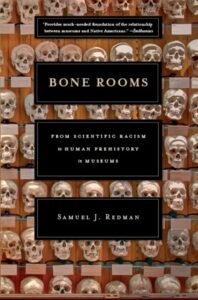Bone Rooms: From Scientific Racism to Human Prehistory in Museums – Samuel J. Redman
 Bone Rooms: From Scientific Racism to Human Prehistory in Museums. By Samuel J. Redman. (Cambridge: Harvard University Press, 2016. pp.373. Cloth, $42.00. Paper, $22.95.)
Bone Rooms: From Scientific Racism to Human Prehistory in Museums. By Samuel J. Redman. (Cambridge: Harvard University Press, 2016. pp.373. Cloth, $42.00. Paper, $22.95.)
The subject of returning looted Native American remains to their tribes has been a topic of discussion in the national news for the last few years, with good reason. The Smithsonian Institution in particular has come under fire, as it still has thousands of human remains in its storage facilities. As Redman points out, only about 3,000 remains have been repatriated.
I don’t really have much to say about this book other than I found it to be extremely disappointing. Redman states right off that he is not going to detail recent controversy over the Smithsonian’s possession of the remains. Fair enough. But the history he presents is repetitive and surface and does not really provide a starting point for where these controversies arose, as I think any conscientious historian should. Writing history doesn’t mean you get to ignore the present. In fact, you have to address it or else your work is not contextualized and has no meaning.
Redman does not provide much new information. I learned that anthropologists became obsessed with collecting human remains as part of the discipline of physical anthropology in order to make discoveries about race. The only problem is that Redman never defines race, nor does he provide the most cursory overview of the state of race science in the nineteenth to eighteenth century, when this work is based. He simply states that physical anthropologists at that time studied race. Even with knowledge of race relations during this period, I felt completely distanced from the text. He also does not explicitly define physical anthropology directly – you have to really hunt for it (and part of it is buried in a footnote) – which is a major oversight considering his book focuses on physical anthropology. You can look it up, but without knowing Redman’s particular working definition, there is still a disconnect from the text.
The idea for this book had so much promise, but Redman’s failure to deliver analysis over straight up narration with a narrow focus, no context, and a slippery timeline, made this book a disappointment. I wouldn’t recommend using it in class except maybe in a graduate class where students can take the time to dissect what works and what doesn’t work. It would be well-suited for a history of science and technology, or a public history class, where it can be compared to in the same genre. In that case it may be instructive.
